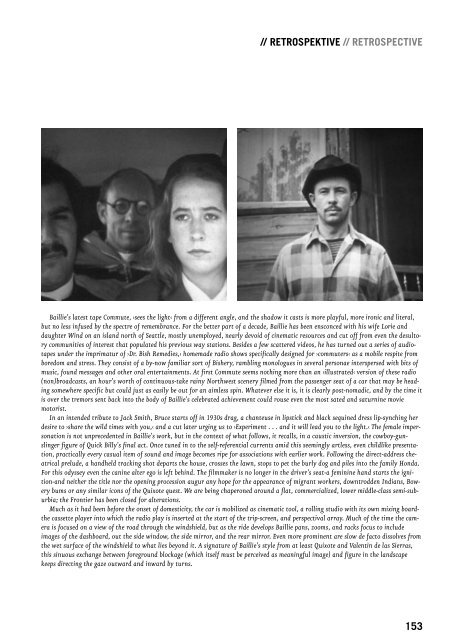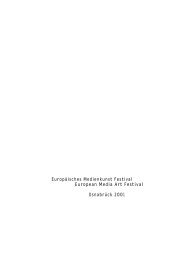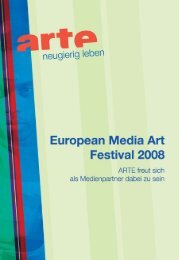Create successful ePaper yourself
Turn your PDF publications into a flip-book with our unique Google optimized e-Paper software.
RETROSPEKTIVE // RETROSPECTIVE<br />
Baillie's latest tape Commute, ›sees the light‹ from a different angle, and the shadow it casts is more playful, more ironic and literal,<br />
but no less infused by the spectre of remembrance. For the better part of a decade, Baillie has been ensconced with his wife Lorie and<br />
daughter Wind on an island north of Seattle, mostly unemployed, nearly devoid of cinematic resources and cut off from even the desultory<br />
communities of interest that populated his previous way stations. Besides a few scattered videos, he has turned out a series of audiotapes<br />
under the imprimatur of ›Dr. Bish Remedies,‹ homemade radio shows specifically designed for ›commuters‹ as a mobile respite from<br />
boredom and stress. They consist of a by-now familiar sort of Bishery, rambling monologues in several personae interspersed with bits of<br />
music, found messages and other oral entertainments. At first Commute seems nothing more than an ›illustrated‹ version of these radio<br />
(non)broadcasts, an hour's worth of continuous-take rainy Northwest scenery filmed from the passenger seat of a car that may be heading<br />
somewhere specific but could just as easily be out for an aimless spin. Whatever else it is, it is clearly post-nomadic, and by the time it<br />
is over the tremors sent back into the body of Baillie's celebrated achievement could rouse even the most sated and saturnine movie<br />
motorist.<br />
In an intended tribute to Jack Smith, Bruce starts off in 1930s drag, a chanteuse in lipstick and black sequined dress lip-synching her<br />
desire to ›share the wild times with you,‹ and a cut later urging us to ›Experiment . . . and it will lead you to the light.‹ The female impersonation<br />
is not unprecedented in Baillie's work, but in the context of what follows, it recalls, in a caustic inversion, the cowboy-gunslinger<br />
figure of Quick Billy's final act. Once tuned in to the self-referential currents amid this seemingly artless, even childlike presentation,<br />
practically every casual item of sound and image becomes ripe for associations with earlier work. Following the direct-address theatrical<br />
prelude, a handheld tracking shot departs the house, crosses the lawn, stops to pet the burly dog and piles into the family Honda.<br />
For this odyssey even the canine alter ego is left behind. The filmmaker is no longer in the driver's seat-a feminine hand starts the ignition-and<br />
neither the title nor the opening procession augur any hope for the appearance of migrant workers, downtrodden Indians, Bowery<br />
bums or any similar icons of the Quixote quest. We are being chaperoned around a flat, commercialized, lower middle-class semi-suburbia;<br />
the Frontier has been closed for alterations.<br />
Much as it had been before the onset of domesticity, the car is mobilized as cinematic tool, a rolling studio with its own mixing boardthe<br />
cassette player into which the radio play is inserted at the start of the trip-screen, and perspectival array. Much of the time the camera<br />
is focused on a view of the road through the windshield, but as the ride develops Baillie pans, zooms, and racks focus to include<br />
images of the dashboard, out the side window, the side mirror, and the rear mirror. Even more prominent are slow de facto dissolves from<br />
the wet surface of the windshield to what lies beyond it. A signature of Baillie's style from at least Quixote and Valentin de las Sierras,<br />
this sinuous exchange between foreground blockage (which itself must be perceived as meaningful image) and figure in the landscape<br />
keeps directing the gaze outward and inward by turns.<br />
153












